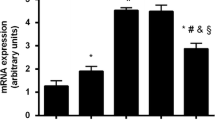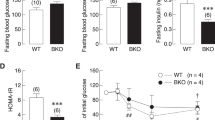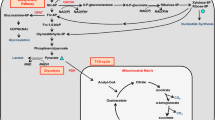Abstract
We have studied gluconeogenesis and intracellular pH levels in normal (+/Y) and X-linked hypophosphatemic (Hyp/Y) mice. Compared with +/Y littermates, Hyp/Y mouse osteoblasts showed a higher rate of glucose production from fructose (10-fold), glutamine, and malate, but no significant difference when α-ketoglutarate was used as substrate. The activities of the pentose cycle enzymes, glucose-6-phosphate dehydrogenase, and 6-phosphogluconate dehydrogenase, were not different in the two osteoblast preparations. Examination of intracellular pH (pHi) using the double excitation of the pH-sensitive dye 2′,7′-bis(2-carboxyethyl)-5(6)-carboxyfluorescein acetoxymethyl ester (BCECF-AM) revealed a significantly lower pHi in Hyp/Y mouse osteoblasts compared with +/Y mouse osteoblasts (7.01±0.03 n=10 versus 7.15±0.04 n=8, respectively; P<0.05). These results show for the first time that osteoblasts are capable of glucose production and that glucose production is altered in the Hyp/Y mouse osteoblast. As altered gluconeogenesis has been associated with reduced intracellular pH in other systems, a similar mechanism may be operative in the Hyp/Y mouse osteoblast. The observed defects may be intrinsic to the Hyp phenotype as the alterations in intracellular pH and gluconeogenesis persisted in vitro, or they may represent impressed memory from the in vivo state and the presumed circulating factor that influences phosphate transport.
Similar content being viewed by others
References
Eicher EM, Southard JL, Scriver CR, Glorieux FH (1976) Hypophosphatemia: mouse model for human familial hypophosphatemic (vitamin D-resistant) rickets. Proc Natl Acad Sci USA 73:4667–4671
Meyer RA Jr, Jowsey J, Meyer MH (1979) Osteomalacia and altered magnesium metabolism in the X-linked hypophosphatemic mouse. Calcif Tissue Int 27:19–26
Meyer RA Jr, Gray RW, and Meyer MH (1980) Abnormal vitamin D metabolism in the X-linked hypophosphatemic mouse. Endocrinology 107:1577–1581
Bell CL, Tenenhouse HS, Scriver SC (1988) Primary cultures of renal epithelial cells from X-linked hypophosphatemic (Hyp) mice express defects in phosphate transport and vitamin D metabolism. Am J Hum Genet 43:293–303
Cowgill LD, Goldfarb S, Lau K, Slatopolsky E, Agus ZS (1979) Evidence for an intrinsic renal tubular defect in mice with genetic hypophosphatemic rickets. J Clin Invest 63:1203–1210
Harvey N, Tenenhouse HS (1992) Renal Na(+)-phosphate cotransport in X-linked Hyp mice responds appropriately to Na+ gradient, membrane potential, and pH. J Bone Miner Res 7:563–571
Boneh A and Tenenhouse HS (1990) Protein kinase C in mouse kidney: effect of the Hyp mutation and phosphate deprivation. Kidney Int 37:682–688
Tenenhouse HS, Henry HL (1985) Protein kinase activity and protein kinase inhibitor in mouse kidney: effect of the X-linked Hyp mutation and vitamin D status. Endocrinology 117:1719–1726
Capparelli A, Roh WD, Dhiman JK, Jo OD, Yanagawa N (1992) Altered proximal tubule glucose metabolism in X-linked hypophosphatemic mice. Endocrinology 130:328–334
Ecarot-Charrier B, Glorieux FH, Travers R, Desbarats M, Bouchard F, Hinek A (1988) Defective bone formation by transplanted Hyp mouse bone cells into normal mice. Endocrinology 123:768–773
Ecarot B, Glorieux FH, Desbarats M, Travers R, Labelle L (1992) Defective bone formation by Hyp mouse bone cells transplanted into normal mice: evidence in favor of an intrinsic osteoblast defect. J Bone Miner Res 7:215–220
Ecarot B, Glorieux FH, Desbarats M, Travers R, Labelle L (1992) Effect of dietary phosphate deprivation and supplementation of recipient mice on bone formation by transplanted cells from normal and X-linked hypophosphatemic mice. J Bone Miner Res 7:523–530
Lobaugh B, Drezner MK (1983) Abnormal regulation of renal 25-hydroxyvitamin D-1 alpha-hydroxylase activity in the X-linked hypophosphatemic mouse. J Clin Invest 71:400–403
Marie PJ, Glorieux FH (1983) Relation between hypomineralized periosteocytic lesions and bone mineralization in vitamin D-resistant rickets. Calcif Tissue Int 35:443–448
Ecarot B, Caverzasio J, Desbarats M, Bonjour JP, Glorieux FH (1994) Phosphate transport by osteoblasts from X-linked hypophosphatemic mice. Am J Physiol 266:E33–38
Nakagawa N, Arab N, Ghishan FK (1991) Characterization of the defect in the Na(+)-phosphate transporter in vitamin D-resistant hypophosphatemic mice. J Biol Chem 266:13616–13620
Rifas L, Dawson LL, Halstead LR, Roberts M, Avioli LV (1994) Phosphate transport in osteoblasts from normal and X-linked hypophosphatemic mice. Calcif Tissue Int 54:505–510
Chen PS Jr, Toribara TY, Warner H (1956) Microdetermination of phosphorus. Anal Chem 28:1756–1758
Boyarsky G, Ganz MB, Sterzel RB, Boron WF (1988) pH regulation in single glomerular mesangial cells I. Acid extrusion in absence and presence of HCO3- Am J Physiol 255:C844–856
Thomas JA, Buchsbaum RN, Zimniak A, Racker E (1979) Intracellular pH measurements in Ehrlich ascites tumor cells utilizing spectroscopic probes generated in situ. Biochemistry 18: 2210–2218
Kurokawa K, Ohno T, Rasmussen H (1973) Ionic control of renal gluconeogenesis II. The effects of Ca2+ and H+ upon the response to parathyroid hormone and cyclic AMP. Biochim Biophys Acta 313:32–41
Kashiwagura T, Deutsch CJ, Taylor J, Erecińska M, Wilson DF (1984) Dependence of gluconeogenesis, urea synthesis, and energy metabolism of hepatocytes on intracellular pH. J Biol Chem 259:237–243
Green J, Yamaguchi DT, Kleeman CR, Muallem S (1990) Cytosolic pH regulation in osteoblasts regulation of anion exchange by intracellular pH and Ca2+ ions. J Gen Physiol 95: 121–145
Green J, Kleeman CR (1992) Role of calcium and cAMP messenger systems in intracellular pH regulation of osteoblastic cells. Am J Physiol 262:C111–1121
Graham CS, Tashjian AH Jr (1992) Mechanisms of activation of Na+/H+ exchange in human osteoblast-like SaOS-2 cells. Biochem J 288:137–143
Fliegel L, Walsh MP, Singh D, Wong C, Barr A (1992) Phosphorylation of the C-terminal domain of the Na+/H+ exchanger by Ca2+/calmodulin-dependent protein kinase II. Biochem J 282:139–145
Nesbit T, Econs MJ, Byun JK, Tenehouse HS, Drezner MK (1994) Normal Pi transport in heterogenous S1 cells of the proximal tubule (PT): evidence that an intrinsic renal abnormality does not underlie XLH. J Bone Miner Res 9(suppl 1):S146
Author information
Authors and Affiliations
Rights and permissions
About this article
Cite this article
Rifas, L., Gupta, A., Hruska, K.A. et al. Altered osteoblast gluconeogenesis in X-linked hypophosphatemic mice is associated with a depressed intracellular pH. Calcif Tissue Int 57, 60–63 (1995). https://doi.org/10.1007/BF00298998
Received:
Accepted:
Issue Date:
DOI: https://doi.org/10.1007/BF00298998




